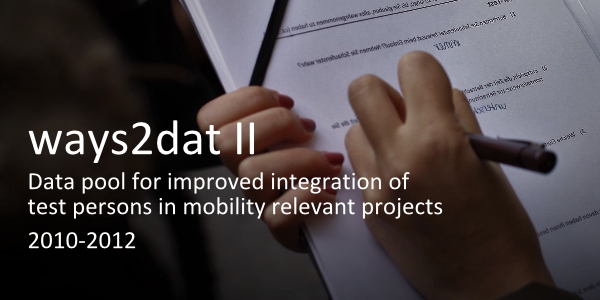ways2dat II

The ways2dat II project built on the results of the ways2dat study. The aim of the ways2dat II project was to design, develop, implement and test a test-person access system in real operation, which enables researchers to reach test persons with mobility relevant characteristics (e.g. mobility restrictions, auto ownership, public transport ticket holders) as easily as possible, namely via key persons.
Client: bmvit, ways2go 3rd call for tenders
Duration: September 2010 to August 2012 (24 months)
Project partners: Brimatech Services GesmbH, AIT Mobility, one’s own gmbH
Project description: In order to follow up, improve, detail and extend the results of the ways2dat II study, the project ways2dat II pushed ahead with the prototypical implementation of a test person pool with which researchers in the mobility field can reach test persons for their empirical surveys more easily, more quickly and more cost-effectively. This is ensured by a so-called key person concept in which researchers reach test persons with mobility relevant characteristics (e.g. mobility restrictions, auto ownership, public transport ticket holders) via key persons (e.g. heads of retirement homes, representatives of sports clubs, teachers at schools).
In addition, the ways2dat II test person access system developed in the project offers services that can increase the quality of the empirical surveys (e.g. consulting, support and assistance in carrying out empirical surveys, identification of innovative survey methods not yet or rarely used in mobility surveys).
In a first step, the desirable basic information collected in ways2dat about the key persons, the test subjects, the inquiring researchers and the procedure in the test person access system were prepared, categorised and subjected to a practical check. Based on this, use cases were defined that will reflect both common and unusual usage scenarios. This means that the preliminary work for drawing up the specifications on the one hand and the specifications for the technical and organisational implementation of the test person access system on the other hand was completed. The prototype was then implemented both technically and organisationally.
Testing (i.e. checking the technical functionality) and evaluation (i.e. checking the organisational and content design) of the prototype was carried out in real operation, i.e. involving real key persons, test persons, researchers and the system operator. All these groups of people tested and evaluated the implementation and made a massive contribution to its improvement.
During the entire project duration of ways2dat II, the consortium, which compared to the ways2dat study will continue to work on this project both in personnel and institutionally unchanged form, is continuously involved in the quality assurance of the test person access system. Topics such as the avoidance of survey bias, the transparent design of process flows or the communication of the various groups of people concerned were dealt with.
After the successful completion of the ways2dat II project, the consortium aimed to launch the test person access system. However, the consortium concentrates on implementation for the Austrian transport and mobility research community. The consortium seeks competent partners through licensing agreements for Europe-wide implementation in the field of mobility or for implementation in other sectors.
Contact: Alex Schubert
